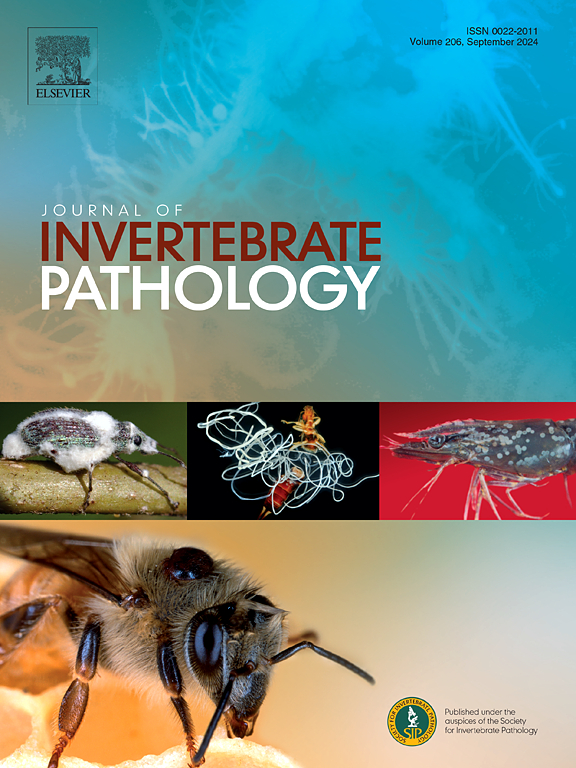以荨麻疹叶螨前rrna为靶点的反义DNA杀螨剂对罗伯特绿僵菌的增效作用。
IF 2.4
3区 生物学
Q1 ZOOLOGY
引用次数: 0
摘要
荨麻叶螨(Tetranychus urticae Koch,螨亚纲:叶螨科)是世界上最危险的害虫之一,也是迄今为止最具抗药性的物种之一。复杂的生物制剂对杀螨剂市场非常有兴趣,因为它们不会毒害生态系统,不会在食品中生物积累,同时,害虫对复杂制剂的抗性更慢。本研究采用由11-mer反义寡核苷酸(寡核苷酸杀螨剂或DNA杀螨剂)tur3与罗伯特绿僵菌组成的复合生物制剂防治荨麻疹。结果表明,DNA杀螨剂与robertsii真菌联合接触施用可显著降低螨的繁殖率。结果表明,DNA杀螨剂tur3与robertsii真菌协同作用,可使螨死亡率提高7倍,使螨繁殖力降低80%。寡核苷酸杀螨剂tur3可使荨麻疹靶标pre-rRNA的表达降低2.5倍,使其防御系统中主要解毒酶(酚氧化酶、酯酶、谷胱甘肽- s转移酶)的活性平均降低2-3倍。寡核苷酸杀螨剂tur3干扰蛋白质的生物合成,导致害虫防御系统酶的产生减少。显然,防御系统的衰减增强了真菌的感染或/并且真菌产生多种降解害虫外壳结构的酶,有助于寡核苷酸杀螨剂tur3的渗透。本研究是首次成功地将寡核苷酸杀螨剂与roberttsii真菌联合应用于有效防治荨麻疹的证据。基于害虫和真菌rnas保守反义序列的寡核苷酸杀螨剂联合应用是一种有效的、选择性的生态植物保护方法。本文章由计算机程序翻译,如有差异,请以英文原文为准。

Antisense DNA acaricide targeting pre-rRNA of two-spotted spider mite Tetranychus urticae as efficacy-enhancing agent of fungus Metarhizium robertsii
Two-spotted spider mite Tetranychus urticae Koch (Acari: Tetranychidae) is one of the most dangerous pests in the world and one of the most pesticide-resistant species ever. Complex biological preparations are of great interest for the acaricide market because they do not poison ecosystems and do not bioaccumulate in food products, simultaneously, pests more slowly develop resistance to complex preparations. In this study we applied complex bioformulation composed of 11-mer antisense oligonucleotide (oligonucleotide acaricide or DNA acaricide) Tur-3 and fungus Metarhizium robertsii for T. urticae control. We discovered that joint contact application of DNA acaricide and fungus M. robertsii significantly attenuates reproduction rate of the mite. Our results indicate that DNA acaricide Tur-3 and fungus M. robertsii act synergistically and lead to a significant 7-times elevated mortality rate and a reduction of 80% in the mite fecundity. Oligonucleotide acaricide Tur-3 causes 2.5-fold reduction of expression of the target pre-rRNA of T. urticae and suppresses the activity of key players of detoxifying enzymes of its defense system (phenoloxidase, esterase, glutathione-S-transferase), on average, by 2–3 fold. Oligonucleotide acaricide Tur-3 interferes with protein biosynthesis causing decrease in production of defense system enzymes of the pest. Obviously, attenuation of defense system enhances fungal infection or/and fungus produces a variety of enzymes that degrade the integument structure of the pest, aiding the penetration of oligonucleotide acaricide Tur-3. This research article is the first evidence of successful application of oligonucleotide acaricide together with fungus M. robertsii for efficient T. urticae control. Combined application of oligonucleotide acaricides based on conservative antisense sequences of rDNAs of pests and fungi is a potent and selective approach for eco-friendly plant protection.
求助全文
通过发布文献求助,成功后即可免费获取论文全文。
去求助
来源期刊
CiteScore
6.10
自引率
5.90%
发文量
94
审稿时长
1 months
期刊介绍:
The Journal of Invertebrate Pathology presents original research articles and notes on the induction and pathogenesis of diseases of invertebrates, including the suppression of diseases in beneficial species, and the use of diseases in controlling undesirable species. In addition, the journal publishes the results of physiological, morphological, genetic, immunological and ecological studies as related to the etiologic agents of diseases of invertebrates.
The Journal of Invertebrate Pathology is the adopted journal of the Society for Invertebrate Pathology, and is available to SIP members at a special reduced price.

 求助内容:
求助内容: 应助结果提醒方式:
应助结果提醒方式:


